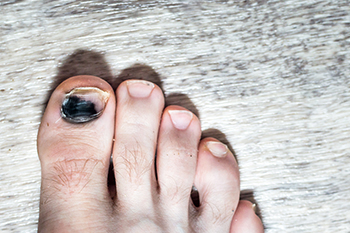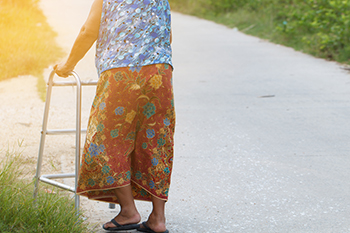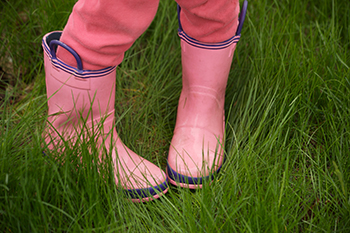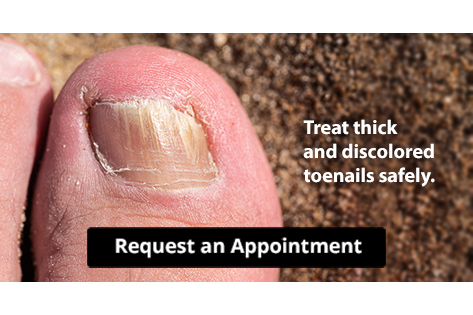Items filtered by date: July 2023
Pronation in Children

Pronation in children can indicate delays in standing, walking, and running. It refers to the inward roll of a child's ankle, often associated with terms like flat feet, flexible flat foot, pes planus, or overpronation. This issue originates from the heel, where the bone rotates inward, leading to weight shifting and walking on the inner part of the foot. Children with low muscle tone or ligament laxity are more susceptible. Excessive relaxation of ligaments can cause the ankles to roll in, disrupting alignment in the knees, hips, and back, potentially resulting in pain. If your child exhibits pronounced pronation, causing problems such as pain, fatigue, or clumsiness, it is suggested to consult a podiatrist for an examination and appropriate treatment.
Flatfoot is a condition many people suffer from. If you have flat feet, contact Desiree Garzon, DPM from County Wide Foot, Ankle, & Wound Care. Our doctor will treat your foot and ankle needs.
What Are Flat Feet?
Flatfoot is a condition in which the arch of the foot is depressed and the sole of the foot is almost completely in contact with the ground. About 20-30% of the population generally has flat feet because their arches never formed during growth.
Conditions & Problems:
Having flat feet makes it difficult to run or walk because of the stress placed on the ankles.
Alignment – The general alignment of your legs can be disrupted, because the ankles move inward which can cause major discomfort.
Knees – If you have complications with your knees, flat feet can be a contributor to arthritis in that area.
Symptoms
- Pain around the heel or arch area
- Trouble standing on the tip toe
- Swelling around the inside of the ankle
- Flat look to one or both feet
- Having your shoes feel uneven when worn
Treatment
If you are experiencing pain and stress on the foot you may weaken the posterior tibial tendon, which runs around the inside of the ankle.
If you have any questions please feel free to contact our offices located in Boynton Beach, and Wellington, FL . We offer the newest diagnostic and treatment technologies for all your foot and ankle needs.
Toenail Issues Common to Runners

Distance runners often experience problems with their toenails, and the three main types are thick nails, bruised nails, and toenail loss. While in many cases the appearance of thick toenails can indicate a fungal infection, in runners they can also be a result of pressure from their shoes and socks, or wearing shoes that don’t fit properly. A toenail that looks blue or black is likely to be caused by a bruise underneath it. The change in color is caused by blood forming under the nail, often from direct trauma to the toe. In some cases, the blood will need to be drained in a medical procedure conducted by a podiatrist. Many runners are surprised when one of their toenails falls off. In most cases, a new nail will form. To avoid losing a toenail, experts recommend being sure that your running shoes fit well, keeping toenails properly trimmed, and making sure your shoes are completely dry before a run. If you notice a bruise, a thick nail, or a loose toenail, it is suggested that you consult a podiatrist sooner rather than later, before the matter worsens and prohibits you from running.
Exercising your feet regularly with the proper foot wear is a great way to prevent injuries. If you have any concerns about your feet, contact Desiree Garzon, DPM of County Wide Foot, Ankle, & Wound Care. Our doctor will treat your foot and ankle needs.
How to Prevent Running Injuries
Many common running injuries are caused by overuse and overtraining. When the back of the kneecap starts wearing out and starts causing pain in your knee, this is commonly referred to as runner’s knee. Runner’s knee is a decrease in strength in your quadriceps and can occur if you’re not wearing properly fitted or supporting shoes. To prevent runner’s knee, focusing on hip strengthening is a good idea, as well as strengthening your quads to keep the kneecaps aligned.
What Are Some Causes of Running Injuries?
- One cause of a common running injury is called iliotibial band syndrome.
- Plantar fasciitis is also another common injury.
- Stress fractures can occur from overtraining, lack of calcium, or even your running style.
Best Ways to Prevent Running Injuries
- Wear footwear that fits properly and suits your running needs.
- Running shoes are the only protective gear that runners have to safeguard them from injury.
- Make a training schedule. Adding strengthening exercises as well as regular stretching can help keep you strong and limber and can lessen the possibility of injuries.
- Stretching keeps muscles limber; this will help you gain better flexibility.
If you have any questions please feel free to contact our offices located in Boynton Beach, and Wellington, FL . We offer the newest diagnostic and treatment technologies for all your foot and ankle needs.
Household Strategies That May Help to Prevent Falling

Research has shown that approximately 25 percent of Americans who are 65 years or older fall every year. Physical harm may happen as a result of falling, and the feet are often affected. A broken foot or toe are common injuries after a fall has occurred, which can limit the ability to complete daily activities. People who fall and are fortunate enough to not become hurt may develop a fear of falling. This can lead to becoming inactive and sedentary, which may be a gateway into other physical conditions. There are simple methods that can be implemented that can effectively prevent falling. These can include having routine physical and eye examinations that help update existing medications and eyeglasses. Additionally, it is beneficial to install grab bars in the toilet and shower area and to improve lighting in the household. If you require more knowledge about fall prevention strategies, it is suggested that you confer with a podiatrist who can provide you with useful tips on foot protection.
Preventing falls among the elderly is very important. If you are older and have fallen or fear that you are prone to falling, consult with Desiree Garzon, DPM from County Wide Foot, Ankle, & Wound Care. Our doctor will assess your condition and provide you with quality advice and care.
Every 11 seconds, an elderly American is being treated in an emergency room for a fall related injury. Falls are the leading cause of head and hip injuries for those 65 and older. Due to decreases in strength, balance, senses, and lack of awareness, elderly persons are very susceptible to falling. Thankfully, there are a number of things older persons can do to prevent falls.
How to Prevent Falls
Some effective methods that older persons can do to prevent falls include:
- Enrolling in strength and balance exercise program to increase balance and strength
- Periodically having your sight and hearing checked
- Discuss any medications you have with a doctor to see if it increases the risk of falling
- Clearing the house of falling hazards and installing devices like grab bars and railings
- Utilizing a walker or cane
- Wearing shoes that provide good support and cushioning
- Talking to family members about falling and increasing awareness
Falling can be a traumatic and embarrassing experience for elderly persons; this can make them less willing to leave the house, and less willing to talk to someone about their fears of falling. Doing such things, however, will increase the likelihood of tripping or losing one’s balance. Knowing the causes of falling and how to prevent them is the best way to mitigate the risk of serious injury.
If you have any questions, please feel free to contact our offices located in Boynton Beach, and Wellington, FL . We offer the newest diagnostic and treatment technologies for all your foot care needs.
Stop Your Toenail Fungus
Facts About Intoeing in Children

When most children begin to walk, their toes point straight ahead. In some cases, as a child begins to walk, their toes point inward. This is termed intoeing, or pigeon-toed, and in most cases goes away on its own. The causes of intoeing are a bit murky, but family history may be involved. Another cause is a twisting of the tibia bone while in the womb, but this often straightens itself out within the first year. A twisting of the femur bone in the thigh is another possible cause of intoeing in children between the ages of 2 and 4 years. This also corrects itself in time, but in severe cases may require surgery. A third cause of intoeing is a curving inward of the foot, which often takes place before birth. This too usually straightens out as the child grows older, but a brace or cast may be used to help straighten out the foot. If your child demonstrates intoeing, it is suggested that you make an appointment with a podiatrist who can take X-rays and examine the child’s feet to determine the best course of action.
Making sure that your children maintain good foot health is very important as they grow. If you have any questions, contact Desiree Garzon, DPM of County Wide Foot, Ankle, & Wound Care. Our doctor can provide the care you need to keep you pain-free and on your feet.
Keeping Children's Feet Healthy
Having healthy feet during childhood can help prevent medical problems later in life, namely in the back and legs. As children grow, their feet require different types of care. Here are some things to consider...
Although babies do not walk yet, it is still very important to take care of their feet.
Avoid putting tight shoes or socks on his or her feet.
Allow the baby to stretch and kick his or her feet to feel comfortable.
As a toddler, kids are now on the move and begin to develop differently. At this age, toddlers are getting a feel for walking, so don’t be alarmed if your toddler is unsteady or ‘walks funny’.
As your child gets older, it is important to teach them how to take care of their feet.
Show them proper hygiene to prevent infections such as fungus.
Be watchful for any pain or injury.
Have all injuries checked by a doctor as soon as possible.
Comfortable, protective shoes should always be worn, especially at play.
If you have any questions please feel free to contact our offices located in Boynton Beach, and Wellington, FL . We offer the newest diagnostic and treatment technologies for all your foot and ankle needs.

